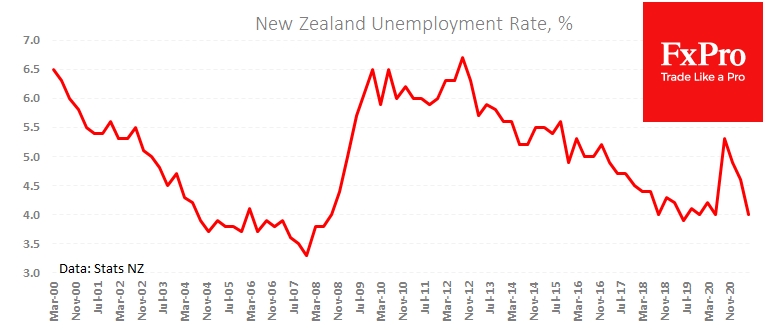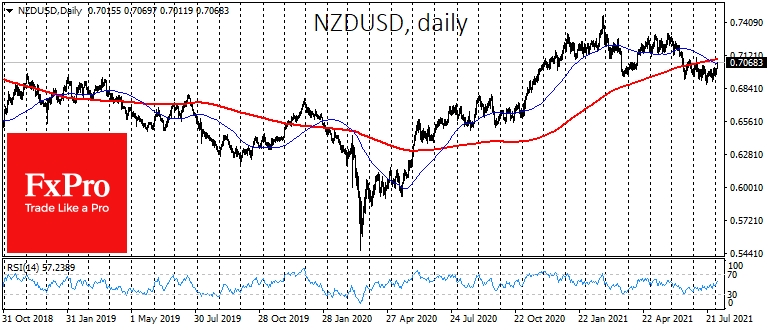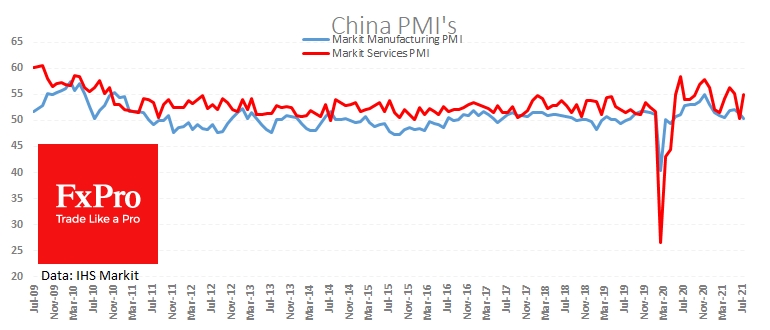The Asia-Pacific region published healthy reports that keep financial markets’ wariness from turning into a sustained sell-off. The New Zealand dollar has surpassed the milestone of 0.7000, the Chinese yuan was testing the highs of the last six weeks, and the Japanese yen was trading near 109 per dollar, its lowest in 8 weeks. 
The New Zealand dollar was up by 0.5% for the second day in a row, surpassing the major round level 0.7000 on strong labor market data. Employment rose 1% in the second quarter after 0.6% in the first. The unemployment rate fell to 4% from 4.6% in the second quarter, returning to pre-pandemic levels.
Technically, the RBNZ has no obstacles to normalize monetary policy as inflation, GDP, and employment have already fully recovered. Additionally, wages jumped by 1.2% in the previous three months, the sharpest jump since 2008.
Although the New Zealand economy has suffered less than other developed countries, it is also supported by the surge in demand for its exports (dairy products) from China and a housing market boom.
Such strong fundamentals present an opportunity for the kiwi to repeat the successes of the early 2000s with a multi-year solid rise. At that time, the NZD/USD doubled within seven years. Although a second flight with the same amplitude is unlikely, the bulls have a 0.73-0.75 area in sight in the short term and a renewal of historic highs near 0.90 in the perspective of a couple of years.
China was supporting the markets’ optimism today with a firm services PMI release. The index rose to 54.9 in July, marking an acceleration after June’s failed 50.3 and alarming manufacturing activity data earlier in the week. 
The dollar retreated to 6.45 Chinese yuan, an area of support since late June, thanks to a neat recovery in demand for risk assets. China caused a stir yesterday with an angry article in a state-owned newspaper about gaming services, further fueling fears that Politburo policies were depriving China of its appeal to foreign investors. However, the article was soon removed, and local stocks saw renewed buying after a strong decline last month.
USD/CNH will signal the USD bears’ strength on the drop under the support line at 6.45 and the 50 SMA. This might clear the way for a quick pullback to the more global lows at 6.35 and further at 6.25 if the Fed continues to demonstrate its slowness in winding down the stimulus.
The FxPro Analyst Team
- English (UK)
- English (India)
- English (Canada)
- English (Australia)
- English (South Africa)
- English (Philippines)
- English (Nigeria)
- Deutsch
- Español (España)
- Español (México)
- Français
- Italiano
- Nederlands
- Português (Portugal)
- Polski
- Português (Brasil)
- Русский
- Türkçe
- العربية
- Ελληνικά
- Svenska
- Suomi
- עברית
- 日本語
- 한국어
- 简体中文
- 繁體中文
- Bahasa Indonesia
- Bahasa Melayu
- ไทย
- Tiếng Việt
- हिंदी
Asia And Oceania Regain Optimism; Kiwi Learning To Fly Again
Published 08/04/2021, 07:12 AM
Updated 03/21/2024, 07:45 AM
Asia And Oceania Regain Optimism; Kiwi Learning To Fly Again
Latest comments
Loading next article…
Install Our App
Risk Disclosure: Trading in financial instruments and/or cryptocurrencies involves high risks including the risk of losing some, or all, of your investment amount, and may not be suitable for all investors. Prices of cryptocurrencies are extremely volatile and may be affected by external factors such as financial, regulatory or political events. Trading on margin increases the financial risks.
Before deciding to trade in financial instrument or cryptocurrencies you should be fully informed of the risks and costs associated with trading the financial markets, carefully consider your investment objectives, level of experience, and risk appetite, and seek professional advice where needed.
Fusion Media would like to remind you that the data contained in this website is not necessarily real-time nor accurate. The data and prices on the website are not necessarily provided by any market or exchange, but may be provided by market makers, and so prices may not be accurate and may differ from the actual price at any given market, meaning prices are indicative and not appropriate for trading purposes. Fusion Media and any provider of the data contained in this website will not accept liability for any loss or damage as a result of your trading, or your reliance on the information contained within this website.
It is prohibited to use, store, reproduce, display, modify, transmit or distribute the data contained in this website without the explicit prior written permission of Fusion Media and/or the data provider. All intellectual property rights are reserved by the providers and/or the exchange providing the data contained in this website.
Fusion Media may be compensated by the advertisers that appear on the website, based on your interaction with the advertisements or advertisers.
Before deciding to trade in financial instrument or cryptocurrencies you should be fully informed of the risks and costs associated with trading the financial markets, carefully consider your investment objectives, level of experience, and risk appetite, and seek professional advice where needed.
Fusion Media would like to remind you that the data contained in this website is not necessarily real-time nor accurate. The data and prices on the website are not necessarily provided by any market or exchange, but may be provided by market makers, and so prices may not be accurate and may differ from the actual price at any given market, meaning prices are indicative and not appropriate for trading purposes. Fusion Media and any provider of the data contained in this website will not accept liability for any loss or damage as a result of your trading, or your reliance on the information contained within this website.
It is prohibited to use, store, reproduce, display, modify, transmit or distribute the data contained in this website without the explicit prior written permission of Fusion Media and/or the data provider. All intellectual property rights are reserved by the providers and/or the exchange providing the data contained in this website.
Fusion Media may be compensated by the advertisers that appear on the website, based on your interaction with the advertisements or advertisers.
© 2007-2024 - Fusion Media Limited. All Rights Reserved.
